Eleven ethnic-minority households in the Hoàng Su Phì District of Hà Giang Province are operating an experimental home-stay service as part of a project to improve the livelihood of ethnic minorities.
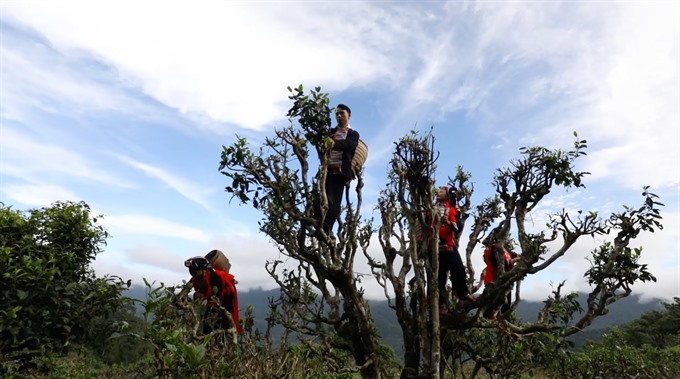
Matured: Locals pick tea from ancient tea trees on top of a mountain in Hoàng Su Phì District. Photo courtesy of CRED
The service is sponsored by the Helvetas Swiss Intercorporation and carried out by the Centre for Rural Economy Development (CRED). Refined models will be used to develop tourism development in the locality. Lê Hương and Hồng Vân explore.
A cloudy morning, while the leaves in the garden are still wet from the mist and roosters crow, the morning sun brightens terraced rice fields and mountains surrounding Suối Thầu Village. Sixty-five-year-old Giảng Thị Mấy gets up to begin her day’s work.
Today she has more things to do than normal as her family is hosting a group of tourists from Hà Nội.
She hurries to chop up dried bamboo branches to make a fire to prepare warm water for the guests.
“It’s a little more busy for me in the past few months," she told Việt Nam News, “But we all feel happy welcoming guests in our homes and we make extra income as well."
Her son, Đặng Văn Nam, said he was given a loan of VNĐ80 million (US$ 3,560) from the project for five years at a lower rate than banks.
“I upgraded my house, build more toilets and bathrooms and bought necessary stuff, like matresses, blankets and mosquito nets,” he said.
"We host at most 20 tourists a week. The business creates jobs for my mother, my wife and myself apart from working on our field."
Mấy’s daughter, Đặng Thị Hà, who lives nearby and runs another homestay, said: “At first, we found the task difficult as we lacked experience and proper infrastructure.”
“We gradually gained experience and became equipped properly with the technical supports of the project. Now we get more steady income and are ready to inspire more households to do the same business."
They are the two first households in Suối Thầu 2 Village, Bản Luốc Commune, Hoàng Su Phì District in the northern province of Hà Giang doing experimental homestay service.
This is part of a project titled "Improving the Livelihood of Ethnic Minorities through Community-Based Tourism" sponsored by Helvetas Swiss Intercorporation, a development organisation, and carried out by the Centre for Rural Economy Development (CRED).
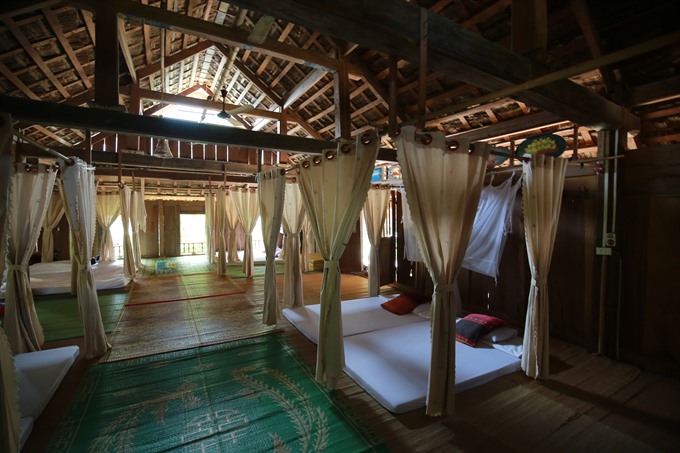
Rural charm: The interior of the home of a local family in Hoàng Su Phì District. VNS Photo Nguyễn Nam
The project has been implemented in four communes of Thông Nguyên, Nam Sơn, Hồ Thầu and Bản Luốc in Hoàng Su Phì, and the two communes in Quảng Yên and Trùng Khánh districts in Cao Bằng Province.
With a total area of nearly 630 sq.km, most of which is high mountains, Hoàng Su Phì has the most spectacular terraced fields in the north. They have been created by 12 minority groups with distinctive cultures, including the Nùng, Dao, Mông, La Chí, and Tày.
“It is the first time I have trekked in such a beautiful terraced rice field,” said Herve Mangon, a tourist from France. “I am absolutely astonished at the beautiful landscape.”
Plassat Nicolas Paul, also from France was impressed with the ancient customs preserved by locals. “I also highly appreciate their belief in holy gods,” he said.
“We chose the destinations because they were supported in CRED’s previous agriculture projects and also because they are located in tourism routes linking Lào Cai and Hà Giang provinces, and the rich of cultural identities with stunning landscape confirms the huge potential for tourism,” said Cao Đại Hùng, manager of the project.
The project organised field trips to other localities for locals to understand the operation of home-stay. It organised cooking classes for them, offered English classes to children and encouraged the villagers to offer more tourism products, such as traditional weaving, dancing and singing.

Spectacular scenery: An aerial view over rice terraces in Hoàng Su Phì District. VNS Photo Lê Hương
In one year, the project has established 11 home-stays ready to receive tourists, and two others on the way, various tour routes, with 500 locals trained in community-based tourism.
So far, more than 700 people have directly benefited from the project while another 2,000 others have received indirect social benefits.
So far, the homestays have received more than 3,200 tourists, of whom more than 630 were foreigners.
“Besides traditional tourism services, such as tour guides, accommodation, transportation and performances, CRED intends to develop new tourism products to enrich tourists’ experience and encourage them to stay longer such as tea processing and rice farming,” Hùng said.
He added that though the current income from tourism at the sites was not high due to small tourist arrival, those offering the service have benefited, encouraging them to continue.
CRED has examined trekking and biking routes in the region as well as setting up handicraft villages for visitors.
“In the next few months, we will host more mountain biking events, where participants may join voluntary works for local communities and promote the tours to more travel agencies in and outside Việt Nam,” Hùng said.
The homestay model will then be applied to more families in the district.
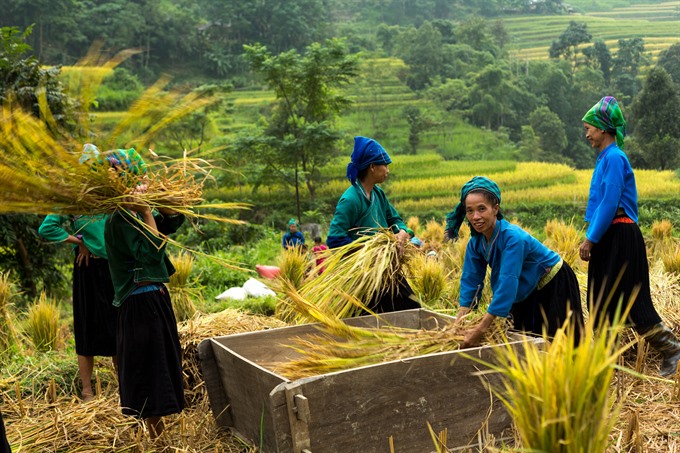
Rural charm: Local women work in the fields in Hoàng Su Phì District. Photo courtesy of CRED
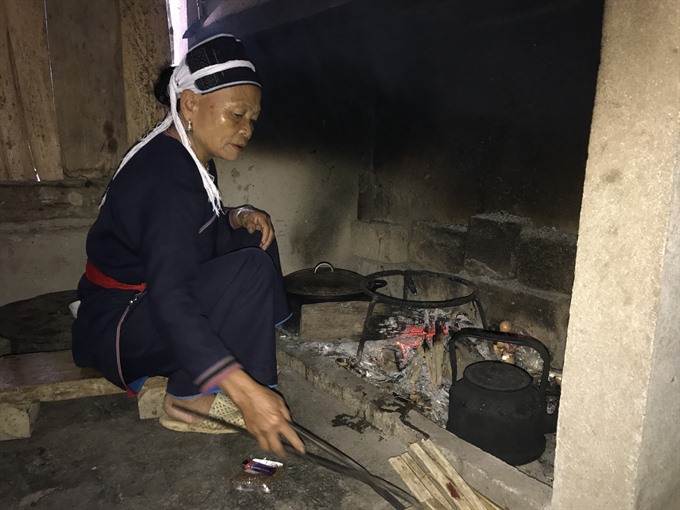
Glowing embers: A woman prepares coals to cook a meal for guests. VNS Photo Lê Hương
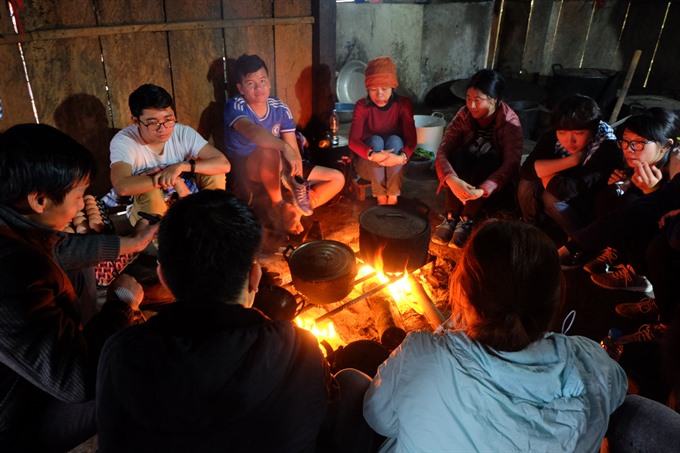
Warm up: Tourists spend a night by a fire at a home in Hoàng Su Phì District. Photo courtesy of CRED
Hoàng Su Phì’s authorities have co-ordinated with Helvetas and CRED to compile a plan for promoting tourism to 2021 with vision towards 2030.
At present, the district receives about 12,000 tourists a year and expects this to rise by 30 per cent thanks to the homestay models and community-based development project.
The district plans to receive 110,000 tourists in 2021, of whom 23,000 will be domestic and 87,000 foreigners. The yearly growth of numbers in 2017-2021 is 25 per cent for foreign tourists, and 28 per cent for domestic guests.
Key potential tourists to the locality come from Europe, Australia and north America, who are intersted in experiencing distinctive cultures, ecological tourism and risky sports.
“To achieve our goals, we will continue to call for individuals, organisations and businesses to support infrastructure in the district,” said Lù Văn Chung, deputy chairman of the district’s People’s Committee. “We will use tourism as a key economic venture.”
Chung said authorities had encouraged communities to offer home-stay services with their real identities, high awareness of protecting the environment and developing household economies.
“By following these guidelines, we hope to avoid failed home-stay models in other places,” he said.
The province plans to create 1,700 jobs from tourism in the next five years, helping to eradicate poverty. — VNS